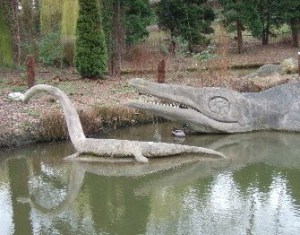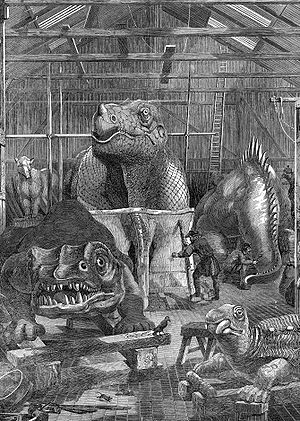Tags
 Located in a corner of Crystal Palace Park is a display that was revolutionary and groundbreaking in its day. In 1854 an exhibition of life size sculptures was unveiled to the public portraying extinct mammals and dinosaurs as they were believed to have looked. While today this may not seem significant given the prevalance of dinosaur imagery and films such as Jurassic Park, it must be noted that this was the first time in the world that such an attempt had been made. While the displays are not considered anatomically correct today, they shaped peoples views at that time and they led to a greater desire to visualize the extinct species of the past. Perhaps because of this exhibit the fascination with dinosaurs started that led to their ubiquitous appearance in modern culture.
Located in a corner of Crystal Palace Park is a display that was revolutionary and groundbreaking in its day. In 1854 an exhibition of life size sculptures was unveiled to the public portraying extinct mammals and dinosaurs as they were believed to have looked. While today this may not seem significant given the prevalance of dinosaur imagery and films such as Jurassic Park, it must be noted that this was the first time in the world that such an attempt had been made. While the displays are not considered anatomically correct today, they shaped peoples views at that time and they led to a greater desire to visualize the extinct species of the past. Perhaps because of this exhibit the fascination with dinosaurs started that led to their ubiquitous appearance in modern culture.
In 1852 after the Great Exhibition at Crystal Palace had closed (1851), the land was reshaped into a public park with lakes and ornamental gardens. The scupltor, Benjamin Waterhouse Hawkins, was commissioned to create sculptures to place in the lakes’ islands - initially of extinct mammals but later expanded to include dinosaurs. He based his creations on then current knowledge. He received guidance from Richard Owen, a well known Paleontologist. The dinosaurs were installed on islands that portrayed different eras in history - Paleozoic, Mesozoic and Cenozoic. The evolutionary progression illustrated was advanced for its day when you consider that On the Origin of Species by Charles Darwin was published several years later.
reshaped into a public park with lakes and ornamental gardens. The scupltor, Benjamin Waterhouse Hawkins, was commissioned to create sculptures to place in the lakes’ islands - initially of extinct mammals but later expanded to include dinosaurs. He based his creations on then current knowledge. He received guidance from Richard Owen, a well known Paleontologist. The dinosaurs were installed on islands that portrayed different eras in history - Paleozoic, Mesozoic and Cenozoic. The evolutionary progression illustrated was advanced for its day when you consider that On the Origin of Species by Charles Darwin was published several years later.
As a note of interest, Hawkins went to New York, USA and was commissioned to create a similar installation in Central Park. Political action stopped the installation and rumor has it the dinosaur models ended up being buried in Central Park. He then went on to work at the Smithsonian.
As the sculptures fell out of favour, they also fell into disrepair. In the 1950s they received their first restoration, but also relocation throughout the park. In 2002 a more complete archival restoration occured and the sculptures were returned to their island homes. There are currently 15 extinct species on display and they are now Grade I listed. They have been referenced in plenty of literature ranging from Paul Theroux to Dorothy Sayers. They can be viewed in the south east corner of Crystal Palace Park.
There is also a museum in the park that provides some history on the exhibit. See http://www.crystalpalacemuseum.org.uk/ for more information.
The park is open year round during daylight hours. Admission free.
Located at: Anerley Hill, Crystal Palace, SE19 2BA
Closest rail: Penge West or Crystal Palace (London Overground)
